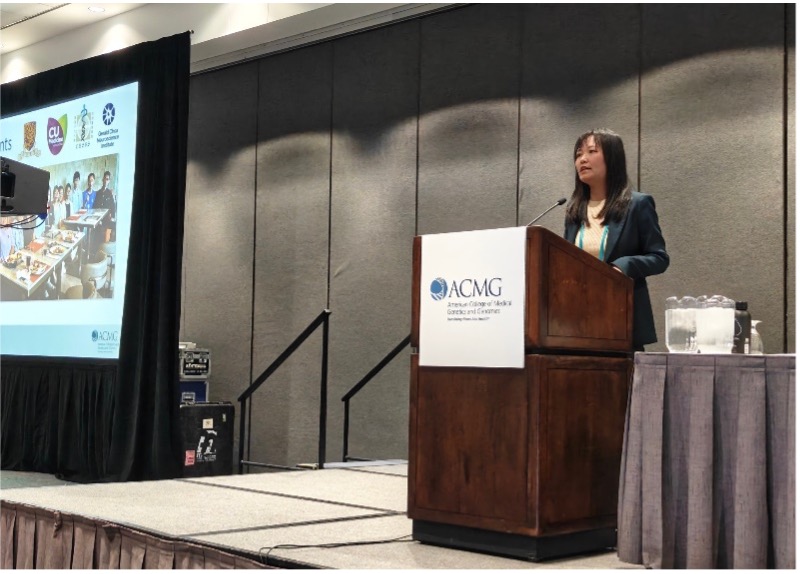News
Related
-

-

Jun 2025
CUHK Researchers Advance Understanding of Neurodevelopmental Disorder Caused by Genetic Changes in a Mediator Complex Gene
Read More
-

May 2025
CU Medicine and the Medical Center at the University of Freiburg in Germany reveal that precise timing of electrical pulses is key to overcoming limitations in current cochlear implant technologies used to restore hearing in deaf individuals
Read More







 Back
Back
Jan 2025CUHK Researcher participates in the Consensus study on Research Priorities for Preventing and Treatment Alzheimer’s Disease and Related Dementia under the Board on Health Science Policy at the U.S. National Academy of Medicine
CUHK Researcher participates in the Consensus study on Research Priorities for Preventing and Treatment Alzheimer’s Disease and Related Dementia under the Board on Health Science Policy at the U.S. National Academy of Medicine
Dementia imposes a significant emotional and financial burden on individuals, families, and communities, a burden that is expected to increase with the aging of the global population. Addressing Alzheimer’s disease and related dementias (AD/ADRD), a group of degenerative neurological conditions, is recognized as a critical priority in biomedical research. The National Institutes of Health (NIH) has dedicated substantial funding to this area over the past decade, laying a groundwork of understanding that offers further opportunities for exploration. Despite these efforts, the rate of advancement has not kept pace with the mounting needs of individuals affected by AD/ADRD and those vulnerable to these conditions.
In response to a congressional request, the National Institute on Aging (NIA) and the National Institute of Neurological Disorders and Stroke (NINDS) commissioned the National Academies of Sciences, Engineering, and Medicine to form a committee. This committee was tasked with evaluating the current biomedical research landscape and identifying key research areas to improve the prevention and treatment of AD/ADRD.
Dr. Kim Hei-Man CHOW, serving as the National Academy of Medicine International Health Policy Fellow, actively contributed to discussions and collaborated on drafting the report alongside the Committee and the Academy’s Staffs throughout the year 2024. The resulting document, named "Preventing and Treating Dementia: Research Priorities to Accelerate Progress," outlines a series of research priorities and associated recommendations designed to overcome obstacles to progress. It was publicly released in December 2024 after vigorous peer review process.
AD/ADRD Research Priorities
The 11 research priorities outlined in the report mirror the collective viewpoint of the committee regarding the most auspicious areas for scientific exploration, aimed at propelling the field forward and bolstering public health. These research priorities are centered on advancing the comprehension of AD/ADRD prevention and treatment. Nevertheless, the committee's primary aim was to ensure that these research endeavors culminate in tangible enhancements in the lives of individuals already grappling with AD/ADRD, while also striving to avert the onset of these conditions in others.
In light of the prevalent occurrence of mixed pathologies among elderly individuals, these research priorities underscore opportunities spanning the entire spectrum of AD/ADRD, rather than exclusively targeting distinct dementia subtypes:
Strategies to overcome barriers to progress on AD/ADRD research priorities
In addition to the recommendations on research priorities, the report also presents interrelated suggestions aimed at addressing overarching obstacles to advancing the specified scientific research priorities. In summary, these include:
In summary, while the past decade has witnessed notable advancements in AD/ADRD prevention and treatment, there still exists a considerable demand for further progress. By fostering collaborative initiatives throughout the biomedical research sector and implementing the strategies delineated in this report, there is potential to envision a future where dementia is both preventable and treatable.
For the complete report, please visit: https://nap.nationalacademies.org/catalog/28588/preventing-and-treating-dementia-research-priorities-to-accelerate-progress. The study—undertaken by the Committee on Research Priorities for Preventing and Treating Alzheimer’s Disease and Related Dementias—was sponsored by the U.S. Department of Health and Human Services. The National Academies of Sciences, Engineering, and Medicine are private, nonprofit institutions that provide independent, objective analysis and advice to the nation to solve complex problems and inform public policy decisions related to science, engineering, and medicine. They operate under an 1863 congressional charter to the National Academy of Sciences, signed by President Lincoln.
Brief biography of Dr. Kim Hei-Man Chow
Dr. Kim Hei-Man Chow is an Assistant Professor in the School of Life Sciences, also an Executive Committee member of Gerald Choa Neuroscience Institute (GCNI) at CUHK. She received her graduate training at the University of Hong Kong, pursued postdoctoral training at Cornell University, and later held a research assistant professorship at the Hong Kong University of Science and Technology. Dr. Chow has been honored with multiple international fellowships, including the US National Academy of Medicine International Health Policy Fellowship, US Alzheimer's Association Research Fellowship, World Economic Forum Global Future Council Fellowship, and China NSFC Excellent Young Scientist Fund.
Dr. Kim Hei-Man Chow. The photo was taken at the National Academy of Sciences Building.
(From left) Dr. Michael McGinnis, The Leonard D. Schaeffer Executive Officer of the National Academy of Medicine (NAM), Dr. Kim Hei-Man Chow, NAM International Health Policy Fellow, and Dr. Gregg Margolis, Director of Health Policy Fellowships and Leadership Programs of the NAM. The photo was taken at the Keck Centre of the National Academies.
(From right) Dr. Victor J. Dzau, the President of the National Academy of Medicine (NAM) and Dr. Kim Hei-Man Chow, NAM International Health Policy Fellow. The photo was taken at the George and Cynthia Mitchell Conference Center of the Keck Centre of the National Academies.